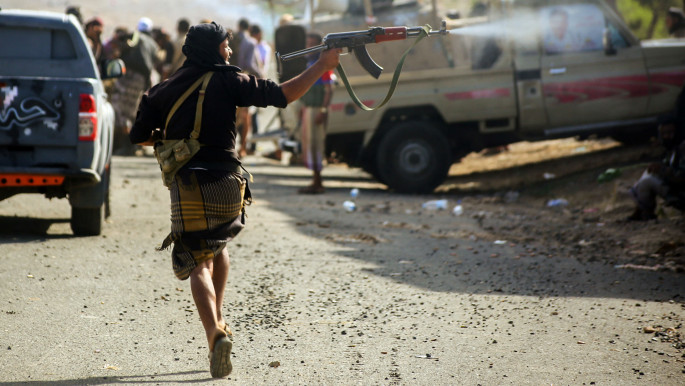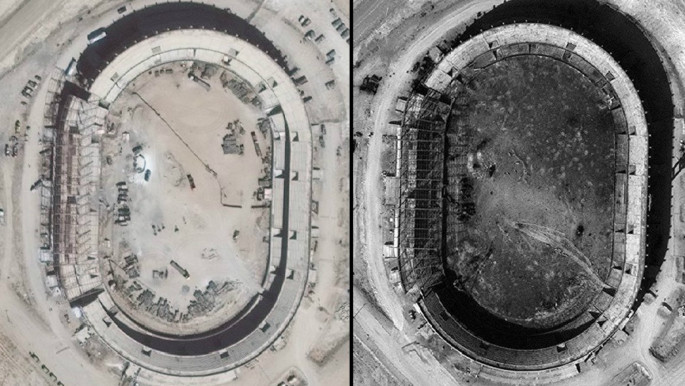Middle East drone wars heat up in Yemen
There were scenes of chaos, with blood splattered across the podium floor and stunned soldiers checking their bodies for wounds. In all, seven people were killed. Among the 20 injured were the army and intelligence chiefs.
Houthi rebels touted the strike, in January, as a successful, intelligence-led operation. It was not the first time the Iran-backed militia had used unmanned aerial vehicles (UAVs) in the war, nor the last. Military experts told The New Arab that drones are changing the face of conflict across the Middle East.
Once the preserve of government forces, drones are increasingly deployed by the Houthis and other insurgents and militias to level the playing field against better-armed adversaries.
It's an alarming work-in-progress, says Yemen's Foreign Minister Khaled al-Yamani.
|
"Iran is using Yemen as a testing ground to develop the range of their missiles and their technology, the drones," al-Yamani said while visiting the UN in New York earlier this month.
According to al-Yamani, there is no downside to drones for the Houthis. They expose militiamen to fewer risks than conventional attacks, and Tehran barely spends any cash on the programme.
"You know how much it costs to operate a drone in Yemen that will kill two, three, four [people], and maim others? It costs only less than $45," al-Yamani said.
"What will happen if they send 50, 60 of these drones to attack?"
In July last year, a Sammad-3 armed drone carried out three strikes some 1,500km away on Abu Dhabi's international airport. UAE officials denied the attack occurred.
In a similar incident in September, officials at Dubai International Airport denied knowledge of another raid, after a Houthi-linked television network described another Sammad-3 drone attacking the transit hub.
 |
You know how much it costs to operate a drone in Yemen that will kill two, three, four [people], and maim others? It costs only less than $45 |  |
Long-distance drone strikes indicated a breakthrough for the Houthis, who have no air force and achieved most of their military gains in Yemen with assault rifles, missiles, off-roaders and rocket launchers.
Saudi Arabia, which leads a military coalition against the Houthis in support of the government of President Abedrabbo Rabbo Mansour Hadi, has blamed such arms transfers on arch-foe Iran and Lebanese Hizballah militants.
The UN's panel of experts on Yemen is probing whether "foreign experts" helped the rebels assemble and upgrade their UAVs, which can now hit targets some 1,500 km away in Saudi Arabia and the UAE, according to its latest report.
 |
|
| Read also: Game of Thrones: Coalition-backed government militias battle it out in Yemen |
Earlier in the war, from 2015 to 2016, the Houthis were limited to importing "complete or partially assembled weapons systems", such as drones and ballistic missiles, from overseas, the experts said in the report.
"They now increasingly rely on imports of high-value components, which are then integrated into locally-assembled weapons systems, such as the extended-range unmanned aerial vehicles," said the report.
The UN experts did not say which foreign powers they were probing, but in previous documents they have pointed to similarities between Houthi drones and ballistic missiles with Iranian weapons systems.
Tehran has repeatedly denied providing military support to the Houthis, who seized the Yemeni capital Sanaa in 2014 and ousted President Hadi.
Riyadh launched an offensive to push back the rebels and restore Hadi to power the next year, backed by the United Arab Emirates.
Yemen is not the only Middle Eastern country with killer drones buzzing overhead.
The military use of UAVs began in the turbulent region back in 1969, when Israel mounted toy aeroplanes with cameras to spy on Egyptian forces along the Suez Canal.
Nowadays, modern versions with hi-tech sensor arrays and explosive payloads are built, deployed and exported by Israel, Turkey and Iran.
Jordan, Iraq, Saudi Arabia and the UAE also possess them, often purchased from China, which has been dubbed a "no-questions-asked exporter" of the technology.
Of course, the Houthis are not the only rebel group to get in on the game. They have also been used – often to deadly effect – by the Palestinian group Hamas, the Islamic State group, the Kurdish Peshmerga, Libyan rebels, and others.
"The future is here, but is not widely distributed yet," Jim Phillips, a Middle East expert at the Heritage Foundation, a conservative think tank, told The New Arab.
"Hizballah probably was the first group to use drones as a terrorist weapon, thanks to Iran's lavish support. Iran also has provided drones to the Houthi rebels, Hamas and other groups."
Iran-backed groups benefit from Tehran's know-how and a state-funded arms programme, which reportedly saw Iran reverse engineer a US-made RQ-170 Sentinel drone that crashed inside the Islamic Republic in 2011.
 |
Terrorist groups that don't enjoy state support are more likely to develop smaller and less capable drones made with off-the-shelf commercial technology |  |
According to IHS Jane's, a security analysis firm, the Houthi-made Qasif 1 was likely developed from Iran's Ababil 2 drone. Likewise, Hizballah's Mirsad-1 drone was likely adapted from a device used by Iran in its war against Iraq in the 1980s.
But, as every online shopper knows, you don't need to be an Iranian proxy to get your hands on a drone.
 |
|
| Read also: Killer toys: How the Islamic State group revolutionised warfare |
So-called "quadcopter" devices sell for as little as $30 on Amazon. While they are not a patch on US-made Predators, they can still be adapted to maim, kill and spy above the battlefield.
"Terrorist groups that don't enjoy state support are more likely to develop smaller and less capable drones made with off-the-shelf commercial technology," said Phillips.
"The Islamic State has been an early adopter of such small drones."
IS videos have showcased the group's handiwork and relatively impressive levels of accuracy with drones, including dropping bombs into the hatches of open vehicles and striking targets from heights of 1,000 feet.
"As this technology evolves and becomes less expensive, it is likely to proliferate more widely, posing a growing risk to civilians and unprepared military personnel," said Phillips, a former researcher in the US Congress.
"Drone technologies, which were rapidly developed in part to counter terrorist groups in remote and hostile environments, are a double-edged sword that also is likely to be increasingly exploited by terrorists."
This highlights a key fact – all drones are not alike.
US-made Predators can travel huge distances, be piloted from thousands of miles away, hover in the clouds for hours and unleash carnage via Hellfire missiles.
An adapted quadcopter might struggle to carry a grenade-sized explosive half a kilometre.
IS and other non-state groups are for this reason limited to less threatening drone use, says Justin Bronk, a drone expert at the Royal United Services Institute, a British military think tank,.
"The payloads are small, such as individual submunitions or grenades, and their range limited," Bronk told The New Arab.
"Thus, they present an irritating threat capable of causing some damage or deaths when used against specific targets – much like snipers – but are limited in terms of the explosive force they can deliver."
In reality, the main battlefield advantage for a drone-touting militia is in targeting their conventional weapons, he added.
Camera-mounted drones can offer artillery crews an "eye in the sky" so they can make every mortar shell count.
"Their most deadly role so far has been providing the ability to spot the fall of rounds and allow corrections in real time for crew-served indirect weapons like mortars, which traditionally are very destructive but inaccurate," said Bronk.
"With a quadcopter allowing a crew to see exactly what the target is, where the first rounds land and make immediate adjustments, they can deliver a lot of accurate firepower very quickly."
James Reinl is a journalist, editor and current affairs analyst. He has reported from more than 30 countries and won awards for covering wars in Sri Lanka, Congo and Somalia, Haiti's earthquake and human rights abuses in Iran.
Follow him on Twitter: @jamesreinl





 Follow the Middle East's top stories in English at The New Arab on Google News
Follow the Middle East's top stories in English at The New Arab on Google News


